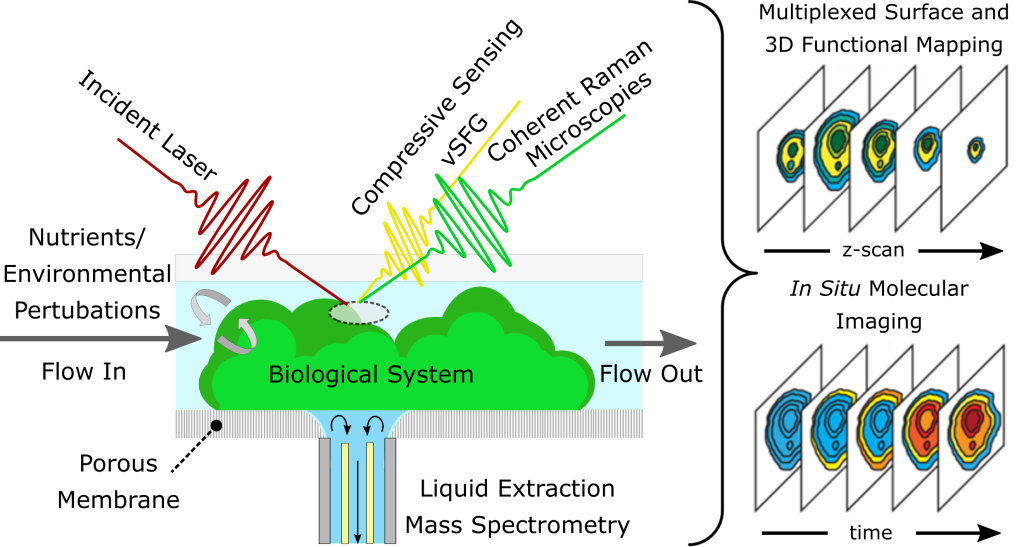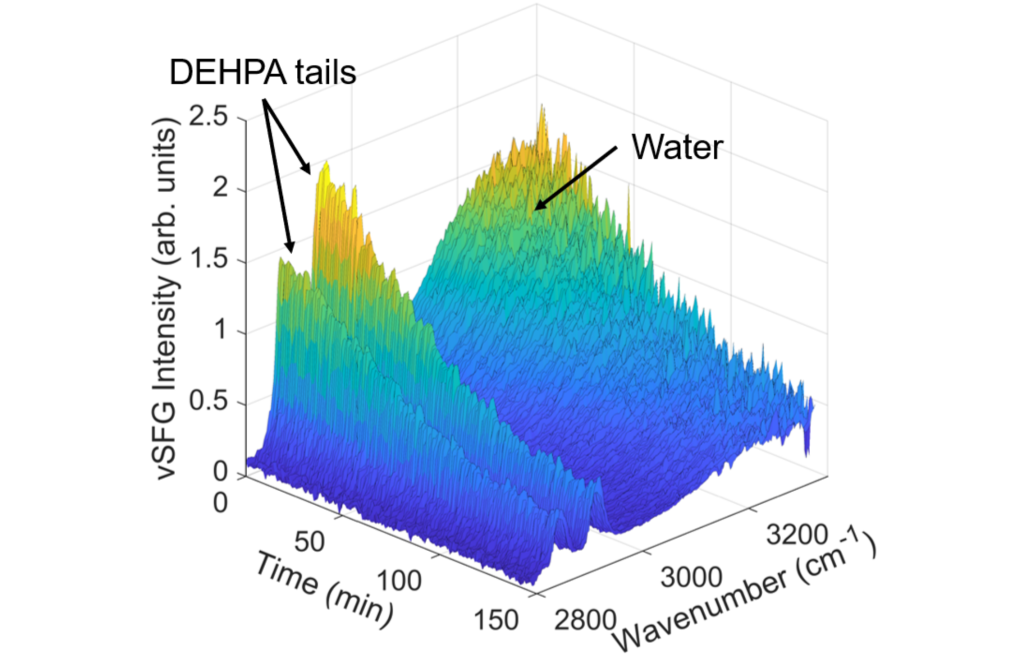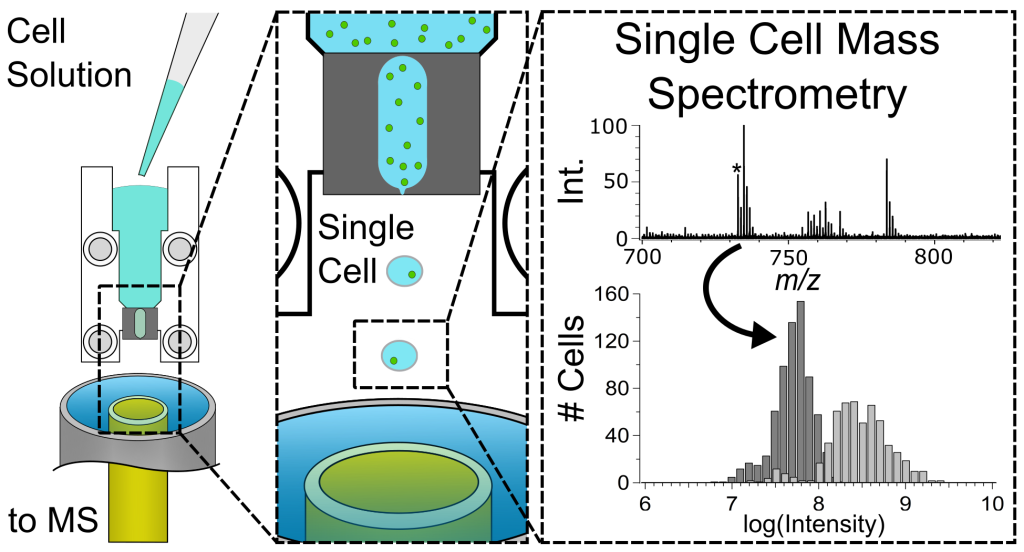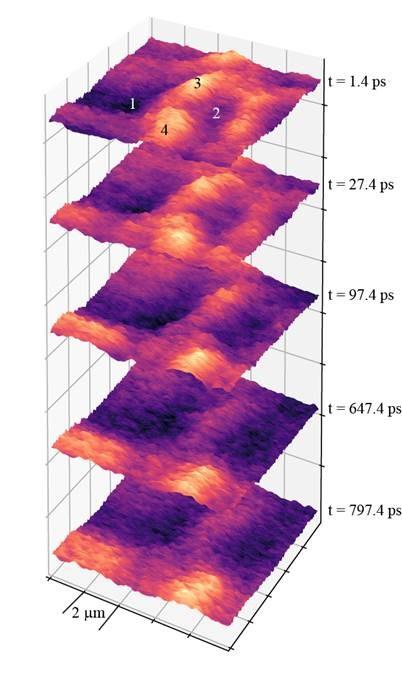Menu

Multi-modal imaging system utilizing mass spectrometry and laser spectroscopies.
Visualizing Plant-Microbe Interactions Using Chemical Imaging
A grand challenge in science is to understand the biological complexity of plant and microbial metabolism and interfaces across scales spanning molecules to ecosystems. Our research is developing novel multi-modal imaging platforms to measure the spatio-temporal distributions of molecules in living systems. Advanced techniques like vibrational sum frequency generation (vSFG) microscopy, liquid extraction–mass spectrometry (LE-MS) and coherent anti-Stokes Raman scattering (CARS) imaging are being used together to understand the biological complexity.

Vibrational sum frequency generation was used to study the liquid extraction of Co2+ using DEHPA ligands at the buried hexadecane/aqueous interface.
Chemical Organization, Structure and Dynamics at Complex Liquid-Liquid Interfaces
A major challenge in separating a mixture of molecules or ions from one another is understanding and controlling the chemical processes that occur at a liquid-liquid interface, such as oil and water. The interface between two liquid phases is a hotspot for molecular self-assembly and anomalous chemical processes that ultimately dictate how species can move from one phase to another. Despite the widespread use of liquid-liquid extraction methods, the chemical events governing selectivity and efficiency are not well understood, which limits our ability to rationally design new separations schemes to meet the demands of the next generation of clean energy technology. A key barrier to obtaining this insight is the current inability to directly probe the structure and dynamics of the molecularly thin interface using conventional spectroscopic methods while not being overwhelmed by the signals originating from the bulk phases. Thus, to understand the events at the interface, one must develop an approach that is uniquely capable of providing chemical insight into the interfacial chemical composition, organization, and dynamics. The overarching goal of this work is to develop a unified understanding of the molecular structure and dynamics governing the mechanisms of chemical separations at liquid-liquid interfaces using surface-specific spectroscopies, such as vibrational and electronic sum frequency generation, in conjunction with neutron scattering methods to advance the design of selective and efficient chemical separations. Our research is trying to answer several fundamental questions: (1) What are the differences in local chemical environment and molecular ordering that mediate selectivity at liquid-liquid interfaces? (2) How does curvature at liquid-liquid interfaces impact self-assembly and selectivity? and (3) How are ultrafast molecular dynamics of interfacial recognition complexes manifested in chemical selectivity? The nonlinear spectroscopic measurement techniques developed in our laboratory are answering long-standing questions underlying selective and efficient chemical separations for the first time by probing different aspects of the same chemical phenomena on characteristic time and length scales. The new insight gained from this work will accelerate the design of selective and efficient next generation separation schemes by providing missing mechanistic insight into the phenomena taking place at the liquid-liquid interface during extraction. Through understanding the mechanisms by which extractions operate, new more efficient and selective separations targeting complex, or undesirable supply streams, such as nuclear waste and rare-earth waste streams, can be developed. This underpins the DOE Grand Challenge Science questions in understanding and controlling matter at the molecular level to ultimately produce efficient energy technologies.

Single Cell Chemical Analysis Using our Liquid Extraction Mass Spectrometry Techniques
Single Cell Mass Spectrometry
Recently we have developed several technologies to enable single cell chemical analysis by mass spectrometry. Typically there is a trade-off between chemical sensitivity and sampling throughput. We have overcome many of these limitations by using the liquid extraction-mass spectrometry (LE-MS) sampling probes our group has pioneered over the last decade. Using LE-MS we have shown the ability to quantitatively characterize single cell chemistry in either an untargeted or targeted manner. We are working on applying these advancements towards understanding the roles cell heterogeneity play in disease and the efficacy of therapeutics.

Transient absorption images taken at different time delays from a mixed halide perovskite film
Spatially and Temporally Resolved Material Characterization at Interfaces
The overarching goal of this research is to surpass the existing analytical capability for nanometer scale spatially resolved material characterization at interfaces under ambient conditions. This is being accomplished through a distinctive merger of advanced spectroscopic and ultrafast time-resolved imaging, scanning probe microscopy, and mass spectrometry. There are two synergistic subtasks in this proposal. In Subtask 1, research is focused on enabling and advancing the ability of ambient surface sampling/ionization mass spectrometry, in combination with other imaging modalities, to study and characterize with submicrometer spatial resolution (100- 1000 nm) molecular and elemental constituents of material interfaces under real world conditions. Our research is also focused on utilizing optical spectroscopic methods with high spatial and temporal resolution to provide an understanding of the ultrafast energy flow and chemical reactions in nanostructures and selected functional nanostructure assemblies by imaging individual nanoparticles and nanostructures with chemical contrast, nanoscale spatial resolution, and femtosecond time resolution. Combinations of techniques that capitalize on both optical spectroscopy and mass spectrometry will provide deeper chemical understanding of interfaces than could either discipline alone. Mass spectrometry operates on the molecular level, while our optical techniques probe nanostructures and their assemblies. The new techniques and tools developed under the umbrella of this research proposal to study and characterize a surface, with submicrometer spatial resolution with the ability to specifically identify a wide range of elements, molecular compounds from small molecules to large macromolecules, and functional domains, over a variety of time scales, will be of great utility in the advancement of the DOE mission (including solar energy utilization, energy storage, fuel cells, and catalysis).

